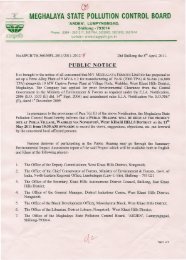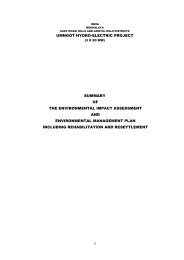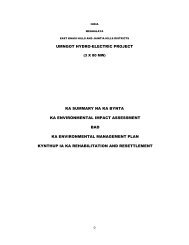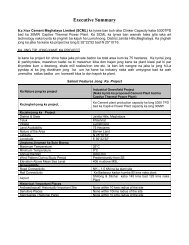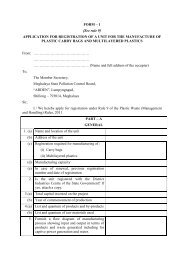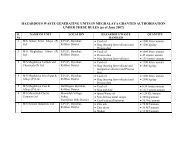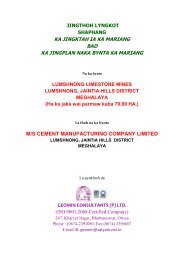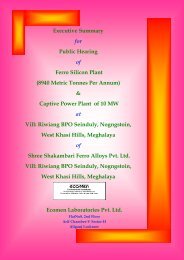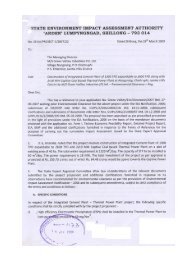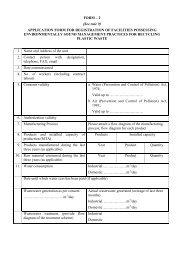chapter - 1 introduction - Meghalaya State Pollution Control Board
chapter - 1 introduction - Meghalaya State Pollution Control Board
chapter - 1 introduction - Meghalaya State Pollution Control Board
Create successful ePaper yourself
Turn your PDF publications into a flip-book with our unique Google optimized e-Paper software.
Hills Cement Co. Limited.<br />
conditions on the kiln wall and clinker, refractory wear and reduced<br />
efficiency due to having to run at high excess air levels to ensure effective<br />
burnout of the fuel within the kiln.<br />
In more modern cement plants, indirect fired systems are most commonly<br />
used. In these systems, neither primary air nor coal is fed directly to the<br />
kiln. All moisture from coal drying is vented to the atmosphere and the<br />
pulverized coal is transported to storage via cyclone or bag filters.<br />
Pulverized coal is then densely conveyed to the burner with a small<br />
amount of primary transport air. As the primary air supply is decoupled<br />
from the coal mill in multi-channel designs, lower primary air percentages<br />
are used, normally between 5 and 10%. The multi-channel arrangement<br />
also allows for a degree of flame optimization. This is an important feature<br />
if a range of fuels is fired. Input conditions to the multi-channel burner<br />
must be optimized to secondary air and kiln aerodynamics for optimum<br />
operation. The optimization of the combustion conditions will lead to<br />
reduced NOx emissions, better operation with varying fuel mixtures, and<br />
reduced energy losses. This technology is standard for modern plants.<br />
Excess air infiltration is estimated to resort in heat losses equal to 65<br />
kBtu/ton. Assuming a reduction of excess air between 20% and 30% may<br />
lead to fuel savings of 130 – 190 kBtu/ton of clinker. The advantages of<br />
improved combustion conditions will lead to a longer lifetime of the kiln<br />
refractories and reduced NOx emissions. These co-benefits may result in<br />
larger cost savings than the energy savings alone.<br />
The disadvantage of an indirect firing system is the additional capital<br />
cost.<br />
Oxygen Enrichment- Several plants have experimented with the use of<br />
oxygen enrichment in the kiln to increase production capacity any energy<br />
savings will depend on the electricity consumed for oxygen generation<br />
approximately 0.01 kWh/scf. Oxygen enrichment may result in higher NOx<br />
emissions, if the injection process is not carefully managed. Oxygen<br />
enrichment is unlikely to result in net energy savings.<br />
Seals- Seals are used at the kiln inlet and outlet to reduce false air<br />
penetration, as well as heat losses. Seals may start leaking, increasing the<br />
heat requirement of the kiln. Most often pneumatic and lamella-type seals<br />
are used, although other designs are available (e.g. spring-type). Although<br />
<strong>Pollution</strong> <strong>Control</strong> Consultants (India) Pvt. Ltd. 119



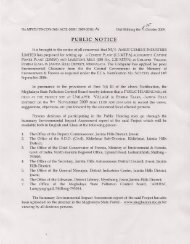
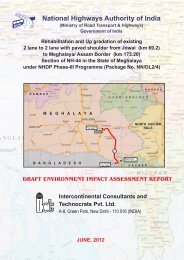

![[FORM I] - Meghalaya State Pollution Control Board](https://img.yumpu.com/49771786/1/190x245/form-i-meghalaya-state-pollution-control-board.jpg?quality=85)

